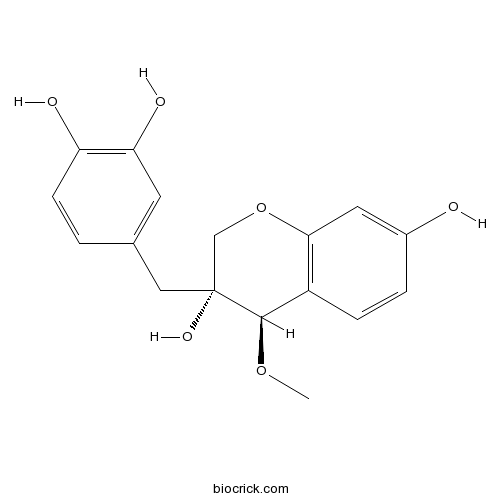4-O-MethylepisappanolCAS# 112529-37-0 |

- 4-O-Methylsappanol
Catalog No.:BCN5863
CAS No.:104778-16-7
Quality Control & MSDS
3D structure
Package In Stock
Number of papers citing our products

| Cas No. | 112529-37-0 | SDF | Download SDF |
| PubChem ID | 13888974 | Appearance | Powder |
| Formula | C17H18O6 | M.Wt | 318.3 |
| Type of Compound | Flavonoids | Storage | Desiccate at -20°C |
| Solubility | Soluble in Chloroform,Dichloromethane,Ethyl Acetate,DMSO,Acetone,etc. | ||
| Chemical Name | (3R,4R)-3-[(3,4-dihydroxyphenyl)methyl]-4-methoxy-2,4-dihydrochromene-3,7-diol | ||
| SMILES | COC1C2=C(C=C(C=C2)O)OCC1(CC3=CC(=C(C=C3)O)O)O | ||
| Standard InChIKey | HHDPKXQKOWHDNA-IAGOWNOFSA-N | ||
| General tips | For obtaining a higher solubility , please warm the tube at 37 ℃ and shake it in the ultrasonic bath for a while.Stock solution can be stored below -20℃ for several months. We recommend that you prepare and use the solution on the same day. However, if the test schedule requires, the stock solutions can be prepared in advance, and the stock solution must be sealed and stored below -20℃. In general, the stock solution can be kept for several months. Before use, we recommend that you leave the vial at room temperature for at least an hour before opening it. |
||
| About Packaging | 1. The packaging of the product may be reversed during transportation, cause the high purity compounds to adhere to the neck or cap of the vial.Take the vail out of its packaging and shake gently until the compounds fall to the bottom of the vial. 2. For liquid products, please centrifuge at 500xg to gather the liquid to the bottom of the vial. 3. Try to avoid loss or contamination during the experiment. |
||
| Shipping Condition | Packaging according to customer requirements(5mg, 10mg, 20mg and more). Ship via FedEx, DHL, UPS, EMS or other couriers with RT, or blue ice upon request. | ||
| Description | 1. 4-O-Methylepisappanol shows moderate neuroprotective effect at 40 microM. |
| Targets | HO-1 |

4-O-Methylepisappanol Dilution Calculator

4-O-Methylepisappanol Molarity Calculator
| 1 mg | 5 mg | 10 mg | 20 mg | 25 mg | |
| 1 mM | 3.1417 mL | 15.7085 mL | 31.4169 mL | 62.8338 mL | 78.5423 mL |
| 5 mM | 0.6283 mL | 3.1417 mL | 6.2834 mL | 12.5668 mL | 15.7085 mL |
| 10 mM | 0.3142 mL | 1.5708 mL | 3.1417 mL | 6.2834 mL | 7.8542 mL |
| 50 mM | 0.0628 mL | 0.3142 mL | 0.6283 mL | 1.2567 mL | 1.5708 mL |
| 100 mM | 0.0314 mL | 0.1571 mL | 0.3142 mL | 0.6283 mL | 0.7854 mL |
| * Note: If you are in the process of experiment, it's necessary to make the dilution ratios of the samples. The dilution data above is only for reference. Normally, it's can get a better solubility within lower of Concentrations. | |||||

Calcutta University

University of Minnesota

University of Maryland School of Medicine

University of Illinois at Chicago

The Ohio State University

University of Zurich

Harvard University

Colorado State University

Auburn University

Yale University

Worcester Polytechnic Institute

Washington State University

Stanford University

University of Leipzig

Universidade da Beira Interior

The Institute of Cancer Research

Heidelberg University

University of Amsterdam

University of Auckland

TsingHua University

The University of Michigan

Miami University

DRURY University

Jilin University

Fudan University

Wuhan University

Sun Yat-sen University

Universite de Paris

Deemed University

Auckland University

The University of Tokyo

Korea University
- Pioglitazone HCl
Catalog No.:BCC2278
CAS No.:112529-15-4
- ent-16alpha,17-Dihydroxyatisan-3-one
Catalog No.:BCN6607
CAS No.:112523-91-8
- CI994 (Tacedinaline)
Catalog No.:BCC2159
CAS No.:112522-64-2
- Citrusinol
Catalog No.:BCN8083
CAS No.:112516-43-5
- Tubuloside A
Catalog No.:BCN2806
CAS No.:112516-05-9
- Neolinine
Catalog No.:BCN6564
CAS No.:112515-37-4
- Isoabsouline
Catalog No.:BCN1955
CAS No.:112513-34-5
- Absouline
Catalog No.:BCN1954
CAS No.:112513-33-4
- Picrasidine S
Catalog No.:BCN6006
CAS No.:112503-87-4
- Aristolactam FI
Catalog No.:BCN6005
CAS No.:112501-42-5
- 6-Aldehydo-isoophiopogonone A
Catalog No.:BCN6629
CAS No.:112500-90-0
- 5-Aminoisoquinoline
Catalog No.:BCC8736
CAS No.:1125-60-6
- Mps1-IN-1
Catalog No.:BCC5590
CAS No.:1125593-20-5
- A 804598
Catalog No.:BCC6198
CAS No.:1125758-85-1
- SKLB610
Catalog No.:BCC3647
CAS No.:1125780-41-7
- 4-Allylpyrocatechol
Catalog No.:BCN6009
CAS No.:1126-61-0
- Iso-mogroside V
Catalog No.:BCN3047
CAS No.:1126032-65-2
- Dicyclanil
Catalog No.:BCC8938
CAS No.:112636-83-6
- U-73122
Catalog No.:BCC5199
CAS No.:112648-68-7
- Garcinone E
Catalog No.:BCN3604
CAS No.:112649-21-5
- BR-Xanthone A
Catalog No.:BCN6007
CAS No.:112649-48-6
- 1,7-Dihydroxyacridone
Catalog No.:BCN7275
CAS No.:112649-95-3
- Fragransin A2
Catalog No.:BCN6008
CAS No.:112652-46-7
- Erigeside C
Catalog No.:BCN6010
CAS No.:112667-09-1
Cytoprotective constituents of the heartwood of Caesalpinia sappan on glutamate-induced oxidative damage in HT22 cells.[Pubmed:19420770]
Biol Pharm Bull. 2009 May;32(5):945-9.
The bioassay-guided fractionation of a MeOH extract of the heartwood of Caesalpinia sappan L. provided two neuroprotective compounds, sappanchalcone (2) and 4-O-Methylepisappanol (3), together with a methoxychalcone, isoliquiritigenin 2'-methyl ether (1), and three aromatic compounds, 4-O-methylsappanol (4), caesalpine J (5), pluchoic acid (6). At concentrations of 20-40 microM, compound 2 showed significant cytoprotective effects against glutamate-induced oxidative stress through the induction of heme oxygenase (HO)-1 in HT22-immortalized hippocampal cells. Compound 3 also showed moderate neuroprotective effect at 40 microM, but compounds 1, 4-6 did not show any protective effects against glutamate-induced cytotoxicity in HT22 cells.


